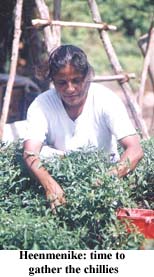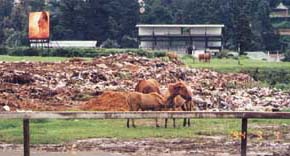 |
 13th June 1999 |
Front Page| |
A fistful of riceBy Kumudini Hettiarachchi
The villagers are beset by two major problems — finding water for irrigation (they depend on the rains and the river) and the marauding elephants which destroy their crops and their livelihood. Seated in the hall of her small brick home, set amidst a plot of land now under chillie cultivation, pretty, sun-burned H.M. Heenmenike (43) talks to us of her attempts to get the village women organised, so that they could rise above the hand-to-mouth existence they'd been leading. With the advent of village-level women's societies as way back as 1974, followed by Janashakthi they were well aware of the need to save as much as they could. Even when the United Nations Development Programme (UNDP) came on the scene in 1995, to help this farming community find a "voice" and a means out of their poverty, the village women had still not come up with a foolproof system. How could they save "something" from their meagre earnings, without letting their families feel the crunch? "There was no way the women could save money. The chances for women to earn money are few. Even if they do get money into their hands, they have to feed their families and it goes fast. At that time most of the families were very poor," Heenmenike, the leader of the village women's group explains. Then they devised a novel scheme. Their staple food was rice, more so after they stopped chena (slash-and-burn) cultivations of kurukkan. They ate rice for breakfast, lunch and dinner. The morning meal would be rice and sambol, the afternoon's rice with one or two vegetables such as wetakolu (ridge-gourd), kekiri, pumpkin or ladies' fingers, which they grew in their plots and in the night more rice was on their table with whatever curry was left over. They hardly ate any proteins because dried fish and "wew malu" (tank fish) were beyond their domestic budgets. The women decided to save what they could and that was rice. They kept aside a fistful ("haal mitak") before they washed the rice and kept it on the fire for their meals. And when they met every Sunday, each woman in a group of six would have a "neliyak", about half a kilo. The week's collection would be three kilos, which they would give to the woman who needed to buy rice that week for her home. The price would be Rs. 60. When she put the money down, it would be divided into six (Rs 10 each) and put as savings into the group's fund. At the end of the week, the women would have savings and one member would get rice at a rate cheaper than at the boutique. The money thus saved, with a fistful of rice, would also be given out as loans getting an interest of 2% those days and 5% now. The families in the village used to seek loans from the "mudalali" at "gini poli" (very high interest rates) but now the situation has changed. They take loans from their fund to buy seeds, fertilizer and agro-chemicals for their crops which include paddy, chillie, onion and vegetables, eloquent Heenmenike says. Then comes the sceptical question. What about repayment? She smiles with tolerance and says 100%. Since 1996, when this began they have collected Rs. 48,000 as "miti haal salli" (money from a fistful of rice). Under the UNDP project, groups like Heenmenike's can become part of a federation of other smaller groups, with the option of injecting their savings into a revolving fund. Then a small group also has access to larger loans. The stranglehold of the mudalali is gone and the women are aware of financial management. Their living conditions have improved, those who had mud-and-thatch houses are now constructing brick homes, purchasing a few luxury items such as TVs, operated by battery as electricity has still not come to Dambagolla. Walking among her chillie plants, some of which though laden with chillies seem to be afflicted with the blight, why is there a shadow of dissatisfaction lurking in Heenmenike's eyes. "Where do we go from here?" she asks. "We just don't have water for our cultivations. The river is drying up. My family is lucky that we have a cultivation well, but what about all the others in this village, which is at the end of nowhere?" Whatever they are able to cultivate on the parched earth, has to be protected from the elephant menace. "Our crops are always under attack by elephants and we spend most nights on the 'messa' lighting crackers to scare them away," she says pointing to a make-shift hut atop a large tree. "But what of the future?" "We don't have irrigation, we don't have electricity, we don't have proper transport. One solitary bus plies the route, erratically. There isn't a proper road. There's no school close-by," Heenmenike laments. Her four children attended a school in Pubbuli, several miles away. With all the disadvantages of a remote village, she herself coached her daughter who sat the Ordinary Level examination last year and the results were four distinctions and several credits. Without facilities, how can we market our harvests? When we achieve all these only will women be fully empowered, she adds.
Garbage amidst the rosesBy Hiranthi Fernando
It becomes a hive of activity during April, its high season, when thousands flock there to enjoy its cool climate. However, Nuwara Eliya today is a far cry from the beautiful resort it was. Ugly buildings, some authorised and others unauthorised, have sprung up on the hills, marring its picture-book beauty. But perhaps the most disturbing factor to visitors and residents is that the town itself is dirty. The greatest problem appears to be the garbage which is now dumped in a part of the racecourse spreading its stench and polluting the crisp, cool air. At one end of the racecourse, close to the new Town Hall building, in full view of the grandstand, is a large unsightly garbage dump. It stands out against the green backdrop of cyprus trees and distant hills. Ponies, stray dogs and crows can be seen scavenging among the rotting collection of garbage. The puddles of water after the rains make the stench worse. A walk round the racecourse is no longer a pleasurable exercise since one has to hold one's nose to do so. The residences and guesthouses that are located across the road must surely have a hard time controlling the flies and mosquitoes. But the city's first citizen has an explanation for the eyesore. Nuwara Eliya Mayor Bandula Seneviratne says that before he took office, this garbage was dumped at Bomuruella near Moonplains, for a number of years. The garbage was dumped from the road down the mountain slope, filling the entire gap between the mountains. The Bomuruella reservoir feeds water to the residents of Welimada area. "In July '97, two busloads of people from Welimada came along with a Provincial Councillor and took me to the site," Mr. Seneviratne said. The Mayor explained that after the garbage is dumped, it is covered over with a layer of earth. When it rains, they are unable to cover itwith earth since the heavy vehicles cannot be taken there. It is then sprayed to control the flies and mosquitoes. However, when The Sunday Times saw the garbage dump both in April and in June, it was exposed to the environment, with no covering of earth. The reason for selecting this seemingly unsuitable site for dumping garbage is that it has been recommended by a Canadian team as highly suitable land for developing as a sports ground. "We have already developed 3 1/2 acres on the other side of the auditorium as a play ground by filling with garbage. Filling and developing the playground took about two years," he says. This ground is now used by the children of Nuwara Eliya for cricket. About 20 teams play there during the dry season. "Almost all sports grounds have been developed by dumping garbage," the Mayor commented. "The Sports Ministry is trying to acquire these grounds. We have given the grounds to the children of Nuwara Eliya free of charge. If the ministry takes it they will have to pay for its use." The Mayor says that if funds are available, they could fill the land with earth from the shoulders of the roads instead of with garbage. This would cost around Rs 1 million. Meanwhile, a site at Meepitimana, towards Ambewela has been developed to make fertilizer using the garbage. Rs. 18 million has been spent on this project. The Mayor says applications have been called for labourers to work on this project. Lectures have been conducted for the public in order to get them started on sorting their garbage before disposal. This would facilitate the making of fertilizer using garbage and solve the problem to a large extent. Till then beautiful Nuwara Eliya, it seems, must live with the garbage. |
||
 |
Front Page| News/Comment| Editorial/Opinion| Business| Sports | Mirror Magazine |
|
 |
Please send your comments and suggestions on this web site to |
|
 NA-ULA:
Down a bumpy sandy track, through paddyfields just turning golden in the
afternoon sun. In the distance, the hazy shape of the glowering Knuckles
range. The track ends in Dambagolla, a village in the Matale district with
about 60 families and a story of survival and also frustration.
NA-ULA:
Down a bumpy sandy track, through paddyfields just turning golden in the
afternoon sun. In the distance, the hazy shape of the glowering Knuckles
range. The track ends in Dambagolla, a village in the Matale district with
about 60 families and a story of survival and also frustration.  The
hill resort of Nuwara Eliya, reputed for its picturesque scenery and bracing
air is a popular holiday destination among both Sri Lankans as well as
foreign tourists.
The
hill resort of Nuwara Eliya, reputed for its picturesque scenery and bracing
air is a popular holiday destination among both Sri Lankans as well as
foreign tourists.